
Reflections
Individuals have many complex identities. Being a citizen is one. While the entire Foot Soldiers collection emphasizes people in their role as citizens, in the Reflections section the images and stories directly spotlight citizenship. The photos are not meant to be sentimental but, instead, to portray the goodness and beauty that can reside in moral indignation. The text adopts the belief that one’s identity as a citizen includes rights and values, history and hope.
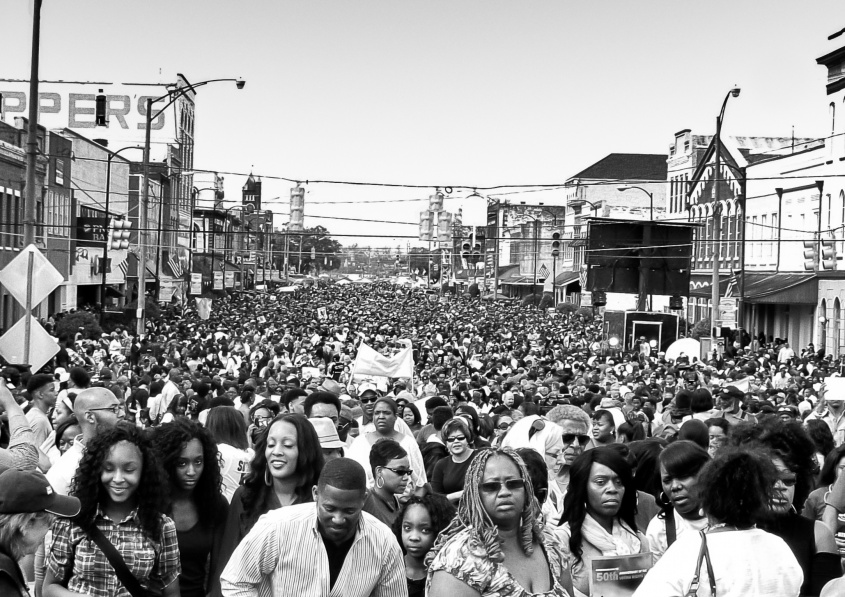
80,000 Cross the Edmund Pettus Bridge, Selma, Alabama, 2015
Tens of thousands gathered to cross the historic Edmund Pettus Bridge to commemorate Bloody Sunday, and the 50th Anniversary of the 1965 Voting Rights Act. Regrettably, in 2013, the Supreme Court gutted the Voting Rights Act. This was followed by a dramatic rollback of voter rights and access. It is as if the stubborn injustices of history, and the discrimination rooted in collective memory are being reasserted.
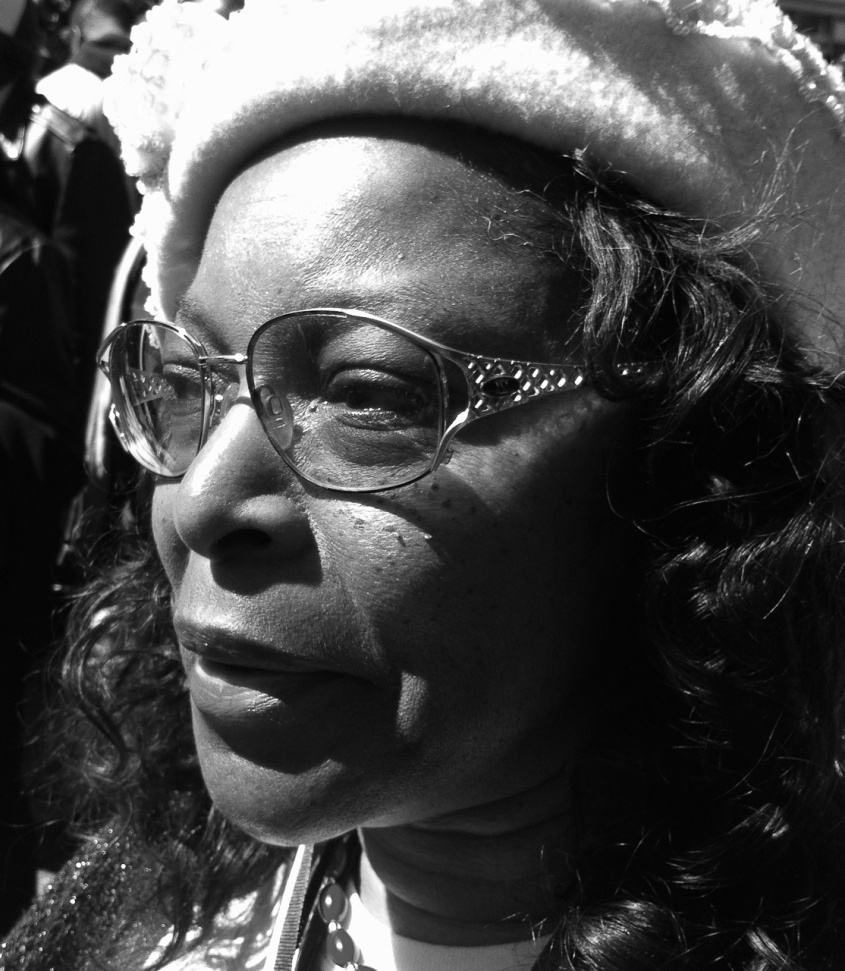
A Foot Soldier from “In the Day,” Selma, Alabama, 2015
Many Foot Soldiers from “in the day” joined the fifty thousand who crowded together to see President Barack Obama walk the Edmund Pettus Bridge. Flanking the President were some of the renowned Foot Soldiers, like the heroes from Bloody Sunday: 103-year old Amelia Boynton Robinson, and Representative John Lewis. Yet, in the massive crowd, cordoned off to the side and away from the main stage where cameras focused on the famous, were lesser-known Foot Soldiers. They were the ordinary citizens, some children or teenagers at the time, who had marched and demonstrated. Without their courage there never would have been a Movement. Standing next to me, watching the video screen that projected President Obama’s image, and straining to hear what he said, one of these Foot Soldiers shook her head, woefully. She spoke of the terrible time Obama had with the Congress, and the rise in racism she attributed to his election. “They sure do like to hate on him,” she sighed.
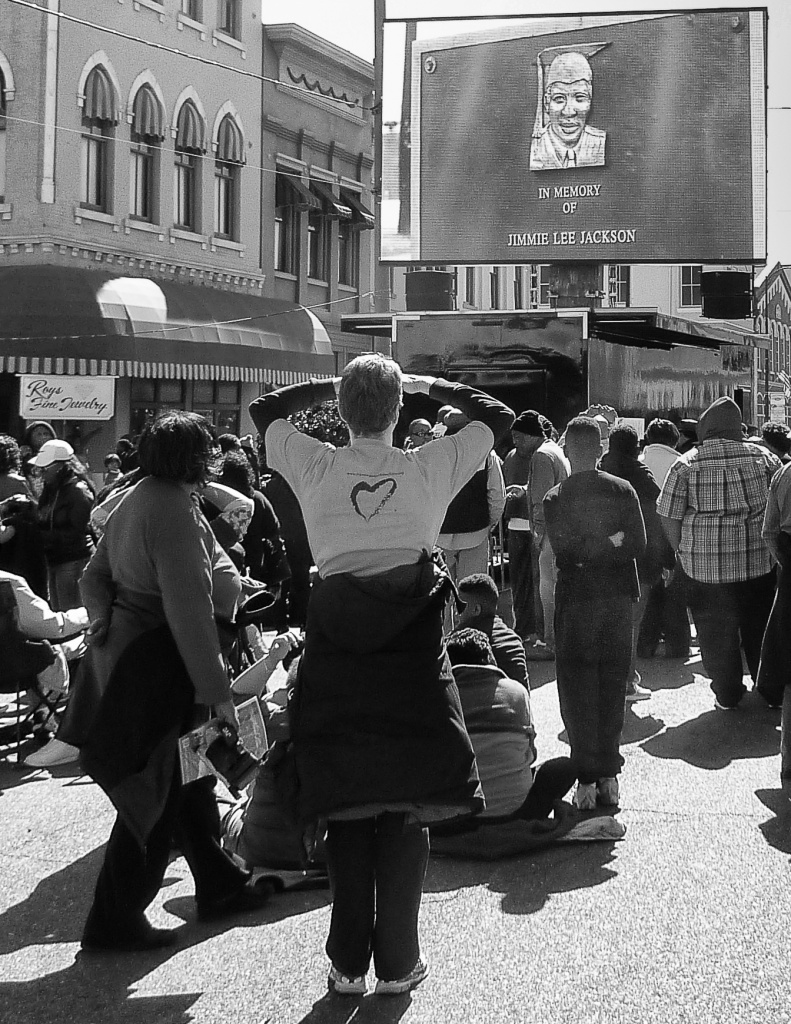
Heartfelt, The Martyr Jimmie Lee Jackson, Selma, Alabama, 2015
There were numerous martyrs on the road to passing the Voting Rights Act. But the death of Jimmie Lee Jackson in 1965 was a turning point. According to the National Civil Rights Museum, Jimmie, his mother, and grandfather were at a demonstration when attacked by state troopers. The three sought refuge in a restaurant, but trooper James Bonard Fowler pursued them, then shot Jimmie twice, while the 26-year old attempted to protect his mother. Recovering after surgery, Jimmie was unjustly served with a warrant for assault and battery with intent to murder a police officer. Subjected to a second surgery, over objections by his doctor, and erroneously given anesthesia instead of oxygen, he died. The local Black community was infuriated. It was then that James Bevel of SCLC proposed marching Jimmie’s body to the state capitol in Montgomery and placing it before Governor George Wallace. Though the body was not carried, they did march. The marches, especially the one on Bloody Sunday, moved the nation to demand the passage of the Voting Rights Act. In 2007, James Bonard Fowler was indicted for the murder of Jimmie Lee Jackson. He pleaded guilty to second-degree manslaughter and served five months in prison.
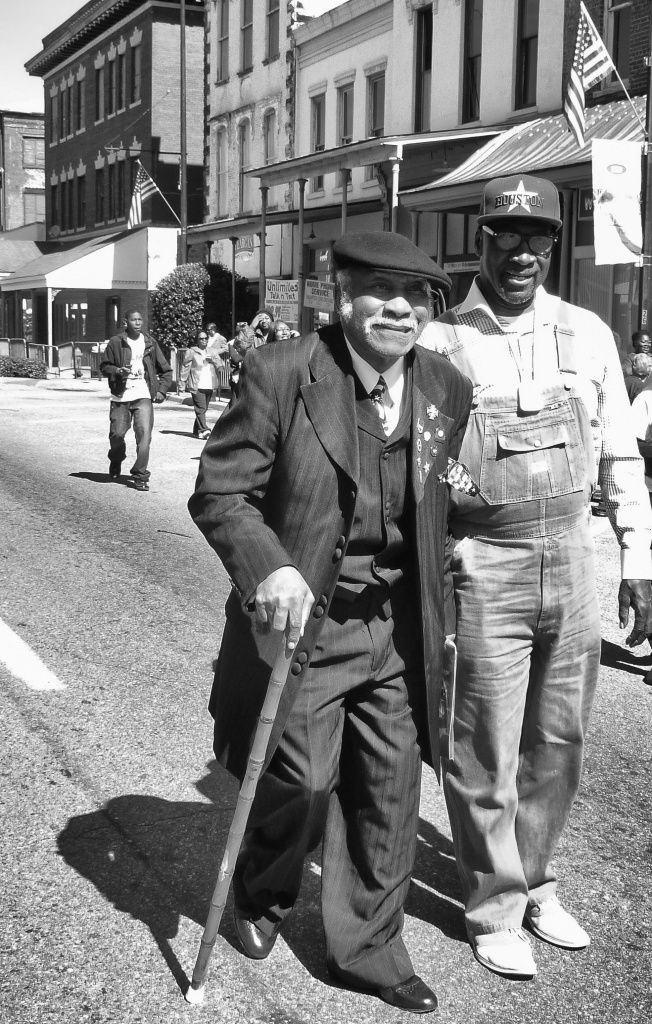
Suit and Bib, Two Men Walking to Welcome President Barack Obama, Selma, Alabama, 2015
The intractable spirit of U.S. history moves through Americans. It can be seen, in daily life, if you look for it closely. It was asleep in this old veteran’s medals, on his lapel. Once awakened, images of segregated military units in World War II appeared, with tales of how Blacks could die for the nation in war but, under Jim Crow, could not vote. The medals spoke of Black servicemen hanging from nooses, strung in trees, by Klan terrorists - the “strange fruit” a Jewish schoolteacher wrote a song about, and Billie Holiday sang. Those bib overalls conjured up indentured servants and Whites working on the rich soil of the Black Belt. In the pockets were stories of Scottish White workers, replaced with slaves by a ruthless English-planter class, and stories of how these White-working men salved their wounded dignity by denigrating Blacks to enhance their whiteness. Sadly, both Whites and Blacks lost much of their humanity in the process.
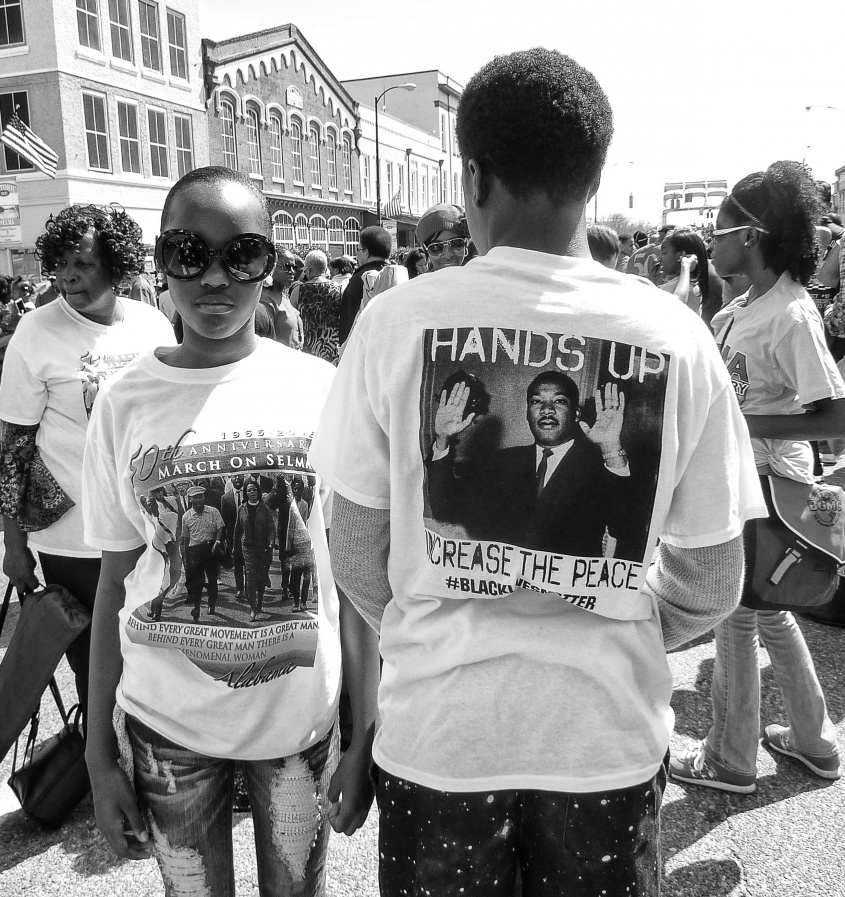
Hands Up: Youths in T-shirts Addressing the Enduring Struggles, Selma, Alabama, 2015
The police slaying of Michael Brown and the Ferguson uprising, the death of Eric Garner in New York, Trayvon Martin in Florida, along with so many other Black men and women killed by police or racists, threw a winding sheet over the Anniversary. As the #BlackLivesMatter Movement made the nation aware of daily killings by police against Blacks, and challenged Caucasians to examine White supremacy and privilege, the commemoration felt tinged with anger, grief and shame. Something portentous was in the mix. Would it become compost for “an energy that can be recycled in the direction of our good,” as bell hooks speaks about? Or, as she warns “a debilitating and destructive force?”
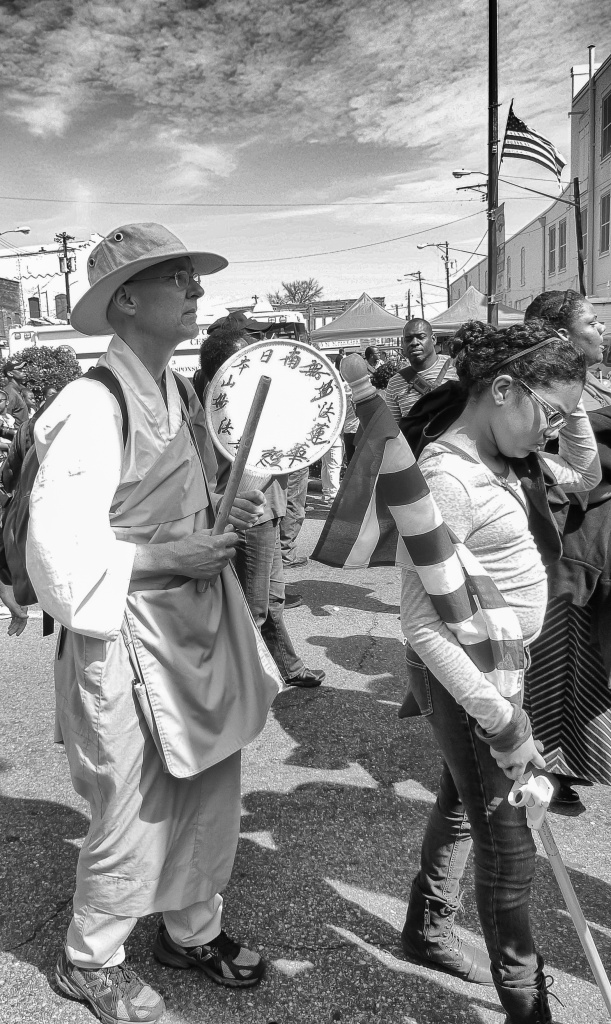
A Buddhist with a Drum Waits to Cross the Bridge, Selma, Alabama, 2015
A Buddhist played a drum; some Jews sounded shofars; Christians and Muslims were visible; and, most likely, atheists, agnostics, pagans, and Hindus were there, as well. This was a peaceful expression of the democracy’s spiritual pluralism. Indeed, before most main events, there was prayer, and despite diverse orientations, many people solemnly bowed their head, out of belief, compliance, or deference
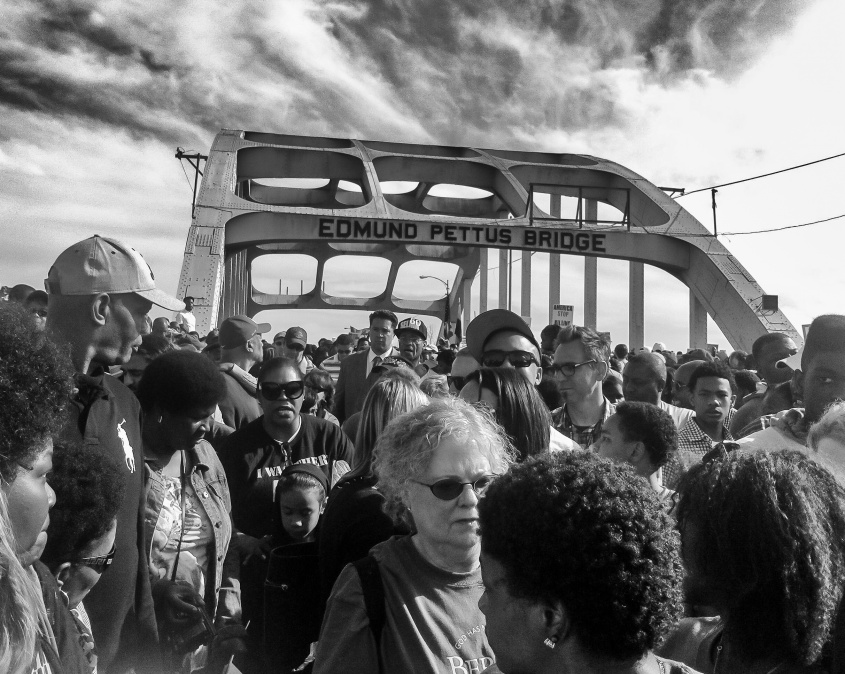
Clouds Over the Edmund Pettus Bridge, Selma, Alabama. 2015
On March 8, thousands crossed under the arch of the Edmond Pettus Bridge where the name of Edmund Pettus, a Ku Klux Klan member, Confederate soldier, and Democratic Senator, remains. Once marchers were across the bridge, a billboard greeted them with an inviting message - “Welcome to President Obama and You.” There was food and refreshments, memorabilia, speakers, and music on that side of the bridge. Marchers could also mill around near the Alabama River. However, heading back into Selma, on the opposite side of the welcome sign, another message spanned the billboard for marchers to read. From top to bottom it said: “Friends of Forrest, Inc. Welcomes You To Historic Selma. Visit Selma’s War Between the States. Historic Sites.” Prominently, to the left side of these words, was the picture of Civil War General, Nathan Bedford Forrest, on horseback. In addition, and boldly written, was a quote attributable to Forrest that stated, “Keep the Skeer On ‘Em.” Not only was Forrest a Confederate officer but, importantly, the first Grand Wizard of the Ku Klux Klan.
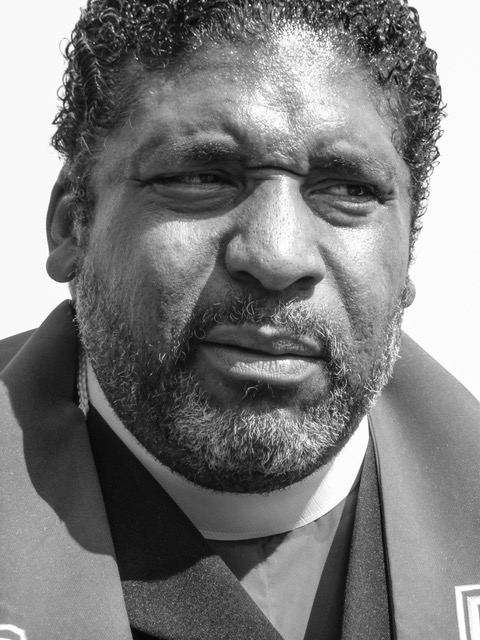
Reverend Dr. William J. Barber II
The Reverend’s thesis: Now is “the middle of the Third Reconstruction.” Each Reconstruction is made of “moral fusion movements,” not merely rooted in political interests, but instead based on deep faith, moral values, and constitutional principles. In the 1800s, fusion movements were central to the First Reconstruction. Caucasians and Blacks joined to reconstruct America with the 13th, 14th, and 15th Amendments, biracial governments, and mutual support for Black liberation and women’s suffrage. Because fusion movements undermine the status quo, violent, immoral backlashes follow, like Jim Crow. Yet, in the 1950s and ’60s, many races, religious groups, the young and old, unions and workers, joined in fusion movements again, giving rise to a Second Reconstruction. They opposed the Viet Nam War, passed the Civil Rights and Voting Rights Acts, expanded social security, and more. Yet again, a backlash followed. But today, signaled by movements that together resist voter suppression, environmental degradation, police violence, economic inequality, and other injustices, Reverend Barber says this is the Third Reconstruction. Many of us hope he is right.

Marchers on America’s Journey for Justice Enter Washington D.C., 2015
The marchers climbed the stairs of the Lincoln Memorial, under the aegis of the NAACP, and assembled on the steps. The colossal statue of Lincoln was behind them. While the Radicals of Lincoln’s day wanted complete Black suffrage, it took him some time to move towards limited Black suffrage, according to historians. Lincoln’s reluctance was no doubt due to a complex set of contradictions and racism, and, most likely, because he understood the power of the vote. He once said, “The ballot is stronger than the bullet.” Indeed, since the founding of the nation, one group or another has been denied the vote by those who feared its power. Speaking to the New York Daily News, Senator Bernie Sanders, who walked across the Arlington Bridge and into D.C. with the marchers, told the reporter, “It's just simply cowardly that these governors and legislatures are making it harder for poor people, for elderly people, and people of color to participate in our political process.” Clearly today’s voter suppression means there are still those who fear the power of the vote.
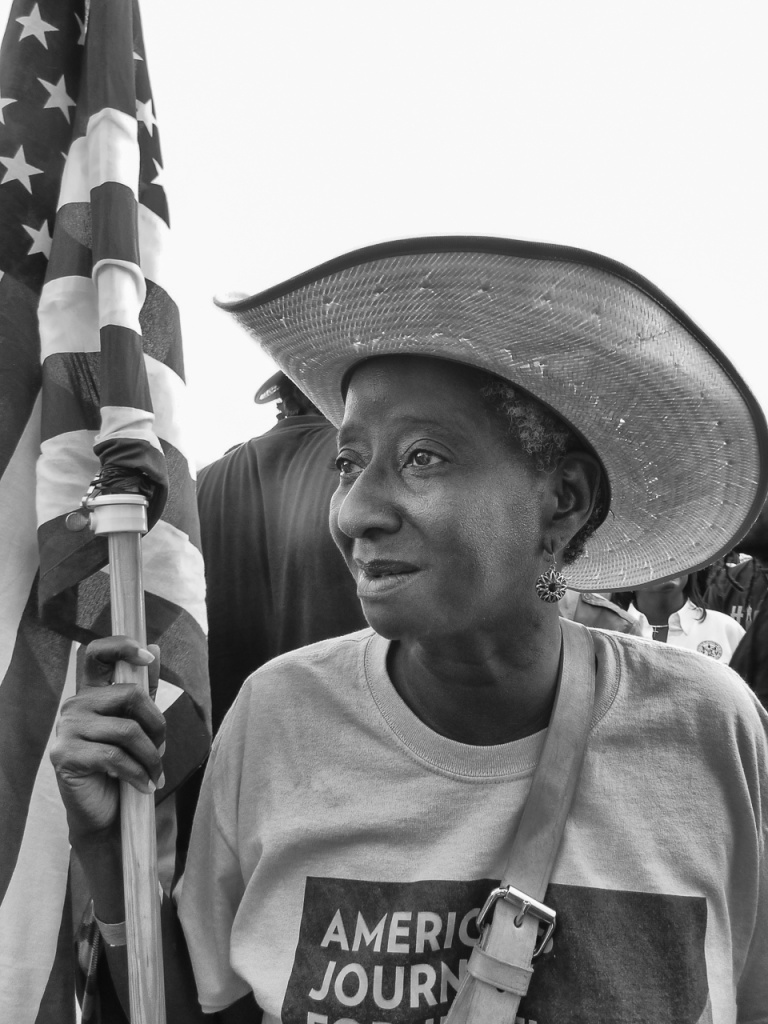
Woman with the American Flag - The Lincoln Memorial, Washington D.C., 2015
She came from Detroit, Michigan to join the NAACP and their Movement partners. She walked the entire journey through Alabama, Georgia, South Carolina, North Carolina, and Virginia, to D.C. Reform Rabbis, approximately 200, marched, as well - some the entire way, others only a portion of the journey. Black nationalism and Jewish nationalism had created a gap between the two communities, after the 60’s. Yet here they walked together. The Rabbis brought along a Torah that they passed, from one Rabbi to another, and from marcher to marcher. The Torah rested on the hearts of those who carried it. I heard a Rabbi in D.C say it made him feel more “open-hearted.” One weekend, a Rabbi from Los Angeles joined the group, and marched in Georgia. There she met the woman in the straw hat. “Why did you come all this way from Detroit and for so many days?” the Rabbi asked. “Because they are killing our babies,” the woman responded. How could the Rabbi not be reminded of the Pharaoh’s order to kill the firstborn? Or about the Holocaust? The gap was closing.
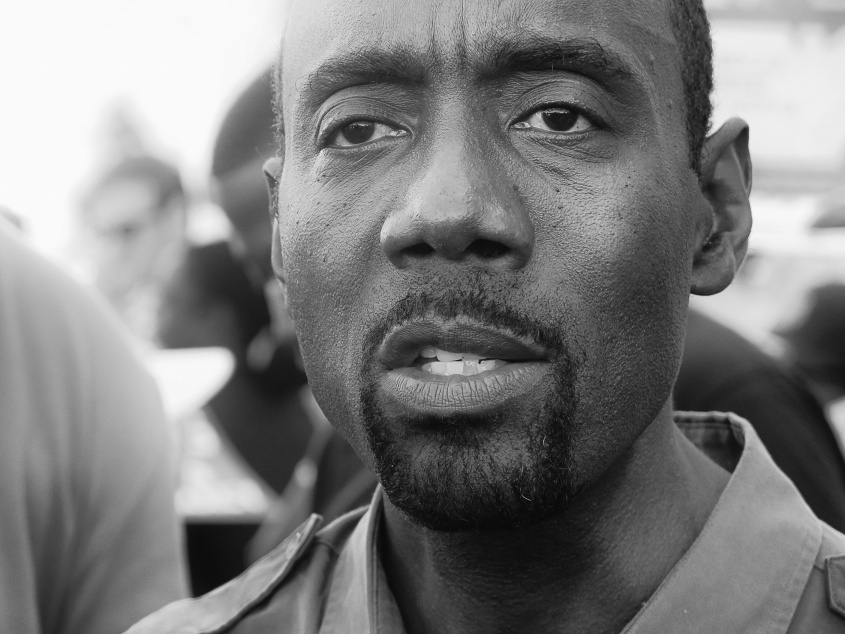
Reverend Cornell William Brooks, President and CEO, NAACP - The Lincoln Memorial, Washington D.C., 2015
Reverend Cornell William Brooks speaks a language of synthesis, melding higher morals, law, history, and activism. “We are trying to convey to folks that the right to vote is a civic sacrament, and the voting booth is, in fact, the alter of our democracy,” he said during the Journey, “and for us to allow voter disenfranchisement and suppression to go on, is a desecration of both.” At the Senate Lawn, he spoke to the advocacy groups that made up the Journey for Justice, calling them “a dazzling constellation of partners.” Then he generously praised the Rabbis for their commitment, drawing that community closer. Importantly, he reminded everyone present that, “Hope is an existential decision.” And sending the Foot Soldiers off, he quoted God’s instruction to Joshua, saying, “Be strong and of good courage.”
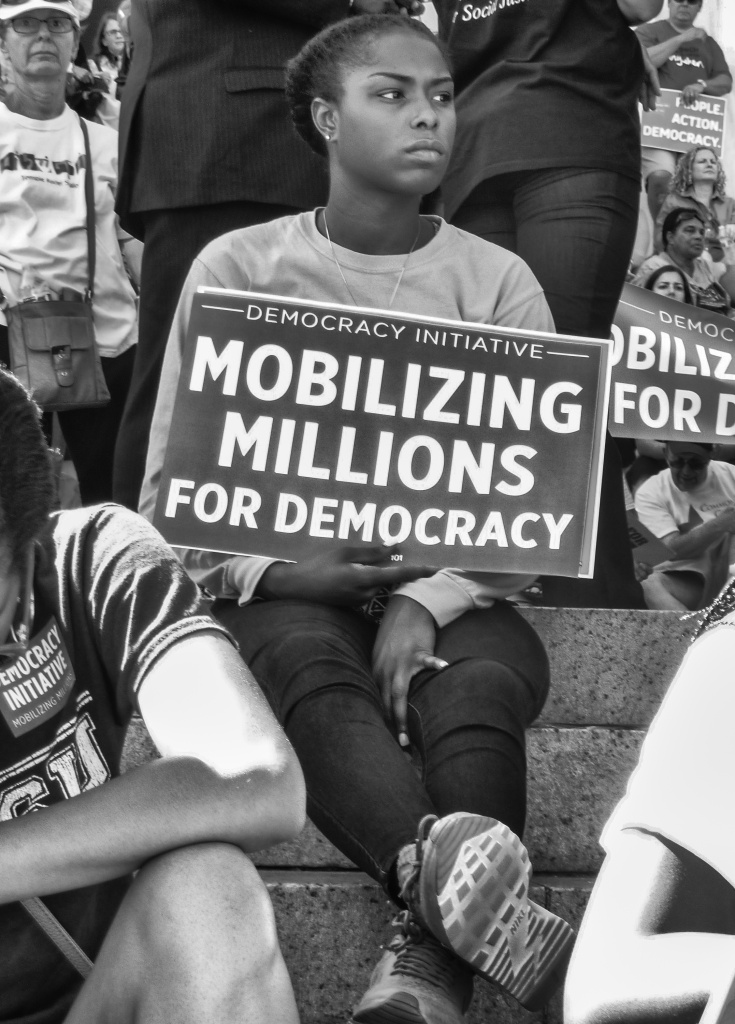
Young Foot Soldier “Mobilizing Millions for Democracy” - The Lincoln Memorial -Washington D.C., 2015
The ghosts of the Founding Fathers hover around the Capital. And so it seemed that Thomas Paine sat near this young woman, reiterating one of his more memorable laments: “When it shall be said . . . my poor are happy; neither ignorance nor distress is to be found among them; my jails are empty of prisoners; my streets of beggars; the aged are not in want, the taxes are not oppressive; the rational world is my friend . . . When these things can be said, then may the country boast its Constitution and its Government.”
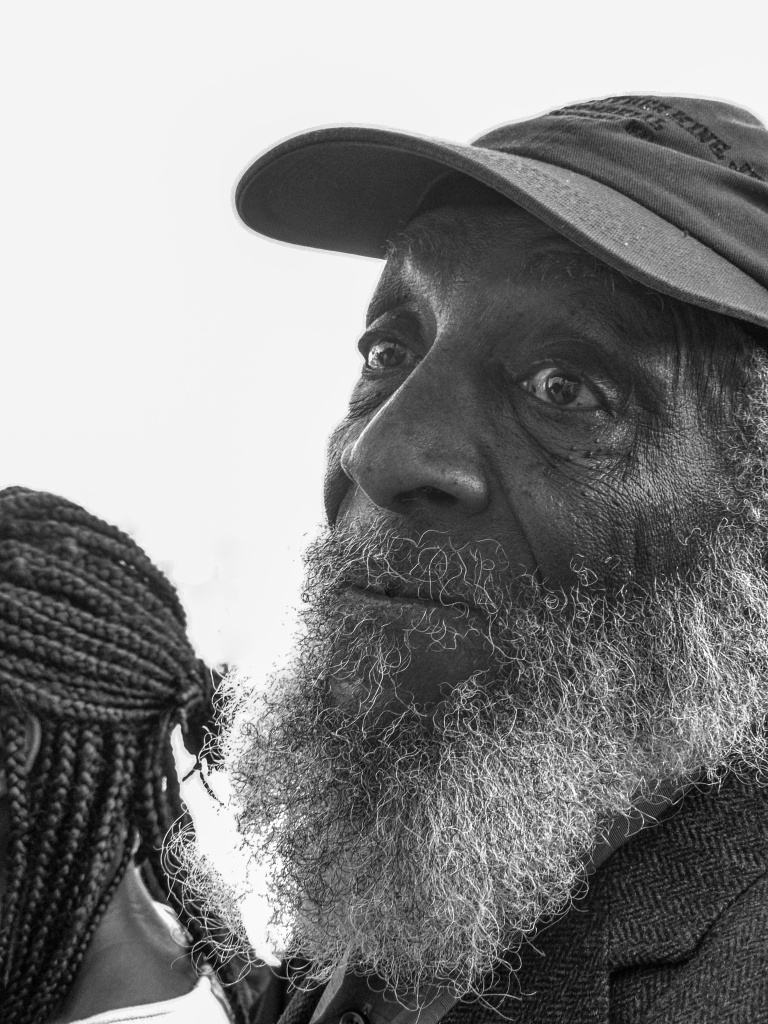
Activist Dick Gregory - The Lincoln Memorial - Washington D.C., 2015
Though he did not speak at the podium, still, the presence of this civil rights legend, and artist activist, added gravitas to the event.
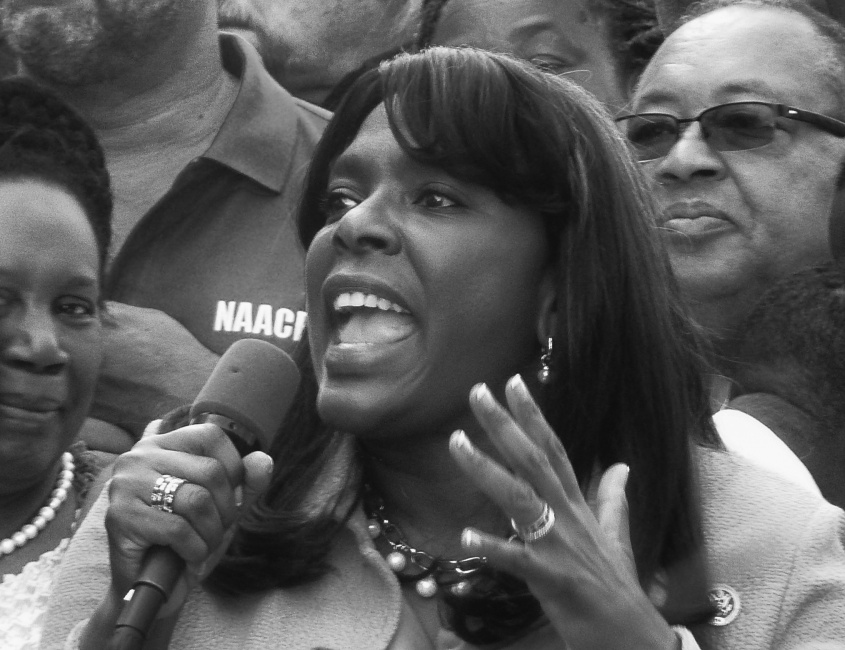
Representative Terri Sewell - Senate Lawn, Washington D.C., 2015
Her website tells us that Representative Terri Sewell grew up nurtured in Alabama’s rural Black Belt where she was the first Black Valedictorian of Selma High. She later graduated Princeton, Harvard, and Oxford. When she returned to Alabama, she became an elected Representative. Her district includes the great civil rights cities of Selma, Tuscaloosa, Birmingham, and Montgomery. Given Election Day is always on a Tuesday, the Congresswoman called for “Restoration Tuesdays,” asking Representatives to take time every Tuesday, while Congress is in session, to build support for the passage of H.R.2867, the Voting Rights Advancement Act of 2015. On the Senate Lawn she reminded people that the Shelby decision offered a challenge to the Congress as the Justices asked them to devise a modern day formula for the 1965 Act. “The Voting Rights Advancement Act does this and more,” she said. So every Tuesday she wears her red, white and blue #restorethevote pin.
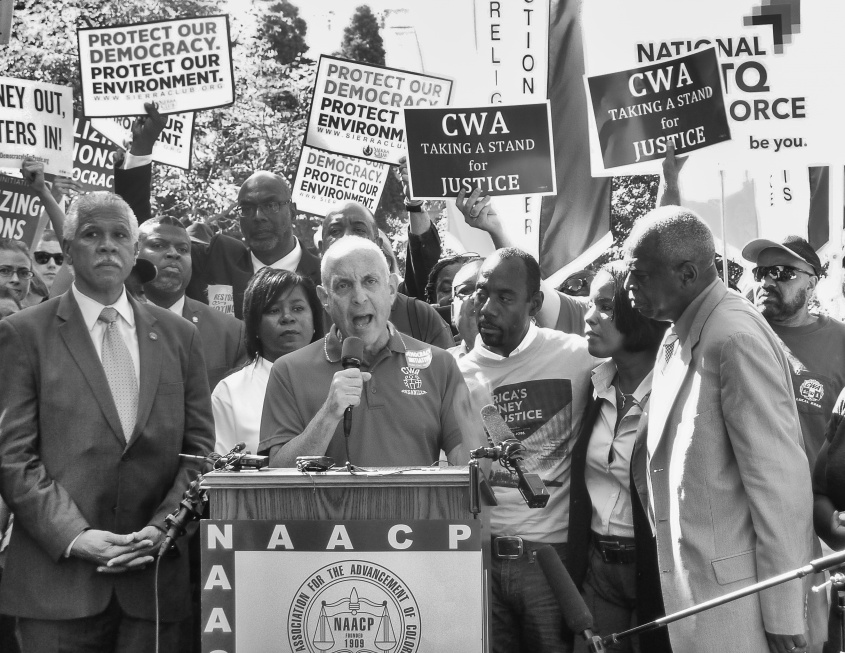
Signs of Unity and Protest: Larry Cohen, Communication Workers of America and the Democracy Initiative - The Senate Lawn - Washington D.C., 2015
Unable to restrain political participation by certain groups, politically or constitutionally, the conservative American Legislative Exchange Council (ALEC) devised various tactics to curtail voter participation. These include Voter ID laws. Purging roles of qualified voters. Eliminating early voting. Reducing polling places. Packing majority-minority districts. Eliminating same-day registration. Using at-large elections. Dividing minority districts. Eliminating out-of-precinct voting. Prohibiting registration drives by organizations - to name just a few of their methods. To stop this assault, the Journey for Justice gathered on the Senate Lawn for their Legislative Advocacy Day. They were armed with key bills: the Voting Rights Advancement Act 2015; the End to Racial Profiling Act; the Raise the Wage Act; and the reauthorization of the Elementary and Secondary Education Act. Departing for the halls of Congress to lobby, their chorus was, “Our Lives, Our Votes, Our Jobs, Our Schools Matter.” The outcome of this struggle, and others across the nation, will determine whether the core democratic value of inclusiveness will live or die.
